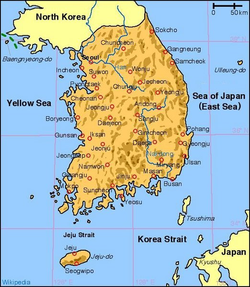
Waves as a result of storm surges from typhoons have resulted in many deaths as well as beach erosion. South Korea is hit by typhoons every year, and because of climate change, their strength and frequency are increasing, causing severe damage to coastal zones. In 2015, the high waves generated by Typhoon Chan-hom hit South Korea's port city of Busan causing considerable damage to Haeundae, the beautiful white sand beach that attracts tourists from all over the world.
Haeundae, with its over one-mile long white beach, is considered one of the greatest natural wonders of the country, but it has experienced serious erosion since the 1970s. Since then, it has shrunk from over 70m wide to less than 30m wide. Before the 1970s, the beach was undeveloped. Since then however, there has been road construction, regional development including hotels and businesses, and tourist attractions. The development was done without the benefits of a Coastal Commission to weigh the risks to the natural environment. Consequently, the development plus the storm surges and wave-induced currents of the summer and winter storm season have resulted in the rapid erosion of the beach since its pristine condition of over 40 years ago.

In addition to waves from storm surges, rip currents plague the beach at Busan. Each year, many people are rescued from the waters off the coast of South Korea's Haeundae Beach. These same currents, in conjunction with strong wave-induced currents and regional development, are the major causes of beach erosion.
South Korea has implemented many strategies for combatting the effects of coastal erosion.
(1) Shore parallel structures: Many offshore breakwaters, seawalls and revetments have been constructed along South Korea's East Coast to protect against the strong waves during typhoons.
(2) Beach nourishment: Beach nourishment was implemented as a means to stabilize the shoreline at Busan.
(3) Non-traditional shore protection structures: Geotubes are a type of coastal structure that can be used to protect the coast. A geotube is a geosynthetic type of material that is stitched to form a tube that is then filled with sand or cement.
(4) Shore perpendicular structures: After construction of a coastal road and seawall along Namae Beach resulted in beach erosion, construction of a short jetty and two submerged reef mounds was proposed. The goal was to reduce wave-induced currents and corresponding beach erosion.
(5) Natural resource restoration: There has also been reef degradation (whitening phenomenon) off the coasts of Korea since the 1970s. Disappearing algae has led to a reduction of fish, abalone, and sea cucumbers. The self-purification capability of seawater has declined dramatically, and it threatens the ecological balance of the ocean -- and fish productivity. South Korea is experimenting with steel slag to promote marine reforestation in areas where damage is significant.
Haeundae Beach has seen some specific efforts by the Korean government to restore its natural beauty. In the 1980s, South Korea began using beach nourishment alone to replenish the shoreline. Adding sand, however, was not enough to mitigate the damage to the beach. A study entitled Mitigation Measures for Beach Erosion and Rip Current concluded with a recommendation that groin-type submerged breakwaters at the sides of the beach, plus large-scale beach nourishments would minimize the rip channel, thereby minimizing the wave-induced currents and rip currents that have had such a devastating effect on the beach. South Korea has now allocated $41 million to build structures in the ocean to channel the waves and currents away from the beach.
________________________
http://ics2013.org/papers/Paper4433_rev.pdfJCR online
Mitigation Measures for Beach Erosion and Rip Current; Kyu-Han Kim, Sung won Shin, Agnes Y W Widayati, 2013
http://repository.unhas.ac.id/bitstream/handle/123456789/7671/158.CC%2009.pdf?sequence=1

Improving the Coastal Hazard Management in Indonesia: Lessons learned from other countries; A.Y.W. Widayati, KH Kim; Sept. 2013
http://www.straitstimes.com/asia/east-asia/typhoon-makes-waves-in-south-kore
Asia; The Straits Times; Typhoon makes waves in South Korea;
https://www.dramafever.com/news/heres-the-innovative-way-south-korea-is-rescuing-its-dying-beaches/; Dramafever; Here's the innovative way South Korea is reusing its dying beaches; March 2014
https://en.wikipedia.org/wiki/Geography_of_South_Korea
Wikipedia; Geography of South Korea


Hello Susan,
ReplyDeleteGreat post! It isn't surprising that South Korea experiences a lot of coastal hazards since it is on a peninsula. This means that it gets hits with waves and development of every side that causes erosion. My country of Thailand also experiences these effects. Tourism is abundant on the coastline due to the tropical weather. Your pictures above really depict how many people enjoy the beaches but this means that there is development and trash getting left behind which increases the rate of erosion. Developers need to be more aware of coastal hazards and reduce their environmental impacts.
As always, an incredible and complete post! I found out sth very interesting while doing some research of my own...I wonder if you read that as well?:
ReplyDelete'Elastocoast' was used in Germany first and now in your country to try to stop coastal erosion. It has been used along the shorelines of the Jeonnam area. Korea’s first revetment built with Elastocoast, installed in 2011, has remained intact even after weathering 12 typhoons!!
what is it? Instead of paving the coastline with concrete or tar, the Elastocoast polyurethane binder bonds rocks and aggregate into a stable yet porous structure that absorbs wave energy. This prevents damage to the revetments and reduces wave run-up.
smart, huh?
https://www.basf.com/hk/en/company/news-and-media/news-releases/kr/2015/11/coastal-fight-erosion.html
Yes, Ana, I had read that article. Amazing, isn't it?!
Delete(I didn't include this information because my "summary" was already too long and I didn't want to overwhelm my fellow students!)
(: I like information!!! Bring it on! (:
ReplyDelete